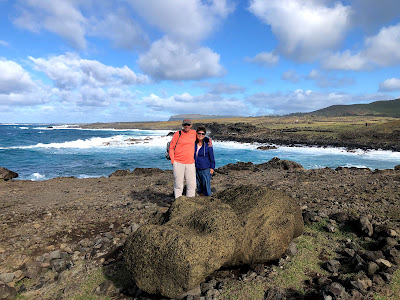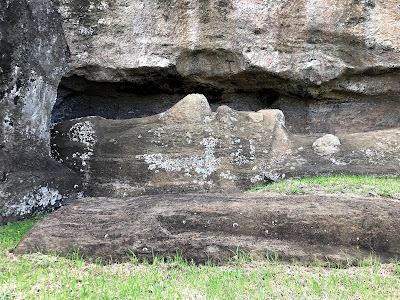 |
| The two newest members of the moai family! |
There is certainly a lot more to Easter Island than just the moai. But, it's hard to ignore the close to 1,000 statues, averaging over 30 feet in height and weighing more than 50,000 pounds, that are scattered about the island. There is so much mystery surrounding them, some of the basic questions are; Why were they carved? How were they transported, sometimes miles away over rough hilly terrain? Why were they all toppled and who toppled them? There are commonly supported answers to all the questions, but without the benefit of written or oral documentation, they all remain "educated guesses".
Yesterday we did a six hour tour of the island that featured stops at some of the most famous locations of moai, as well as the quarry where they were carved. Our tour guide was Peter, the owner of the Hareswiss, where we are staying. Although he is originally from Switzerland, he has lived on the island a number of years and has a great deal of knowledge about all things Easter Island, as well as about American movies and music!
The completed moai were transported from the quarry to what are known as "ahu" or platforms along the coast. Probably the easiest way to describe an "ahu" is like a huge outdoor ceremonial alter constructed of stones. As a general rule the moai were placed looking inward toward the land. A common belief is that they were built honoring past leaders/elders of the various tribes or klans that inhabited the island. They face inland to be watching over and providing protection to the land and it's people. There are two noted exceptions to the moai facing inland. One is the quarry where they were carved (more on this later) and the other is a series of seven moai facing out to sea as if to be guiding weary travelers in small boats to shore.
Our first stop was at a beautiful location on the coast with huge waves of blue water crashing over the lava rocks. There was a platform with several moai that had not been restored to their upright position. Some were lying face down while others were face up. One of the long term concerns is the continued gradual deterioration of the moai due to the elements and small plants called lichens. Ironically, the moai lying face down are provided with some protection and the facial features are deteriorating at a much slower rate.
 |
| Kind of like me, this guy has had a little too much sun exposure over the years |
 |
| Time and the elements of nature have taken it's toll on this moai |
From there we made our way to "Rano Raraku", the quarry, where these massive statues were carved. The moai were carved from single pieces of stone. They were carved while in a laying position. It was believed that each moai had a "master carver" who oversaw the work of teams. It is also thought that it took up to two years to complete one moai. Once the front of the moai was completed they were carefully lifted into an upright position and slid down the hillside into an awaiting hole. Once secured in the hole the backside would be completed and the moai would be transported to it's appropriate location, where it would be placed upright and facing inland.
As you can imagine, the carving and transporting of these was no easy task! It is believed they were transported either by some type of sled or gradually tipping and walking them forward inch by inch. Either way, it required a lot of time, skill and effort by a lot of people!
According to Peter, there are 397 moai remaining at the quarry. As he put it, "it was like they left work on a Monday and didn't return on Tuesday". Many of them appear to have been completed and awaiting transportation, while others were in the early stages. It is also thought that in addition to the ones visible, that there are likely a large number that over the years were slowly covered with soil and grass. It was very surreal to walk through the quarry and imagine what it must of looked like on a busy day.
 |
| This moai was in the early stages of carving when work ceased. |
Our final stop was at Tongariki, the largest ceremonial platform on Easter Island. This platform is located less than a mile from the quarry. Here there are fifteen moai that have been restored to their upright position, including one that weighed over 172,000 pounds (the largest known one on the island). Most, if not all the moai on the island were believed to have been toppled during island tribal wars as a way of demoralizing the other tribes, or by explorers visiting the islands. These particular moai were later swept inland by a massive tsunami that hit the island in the twentieth century, making the restoration project even more challenging and impressive to see.
 |
| Tongariki from a distance. After being toppled, these were later swept inland by a tsunami. |
 |
| I had to get a picture of this old VW microbus that's been converted into a "snack shack" |
After a little rest, we finished the day with a walk down to the waters edge to enjoy a beautiful sunset. It's too bad that the moai between us and the sunset were facing inland, they missed a nice show!
 |
| The crowd gathering for sunset |
 |
| They're missing a nice show! |







